Related Research Articles
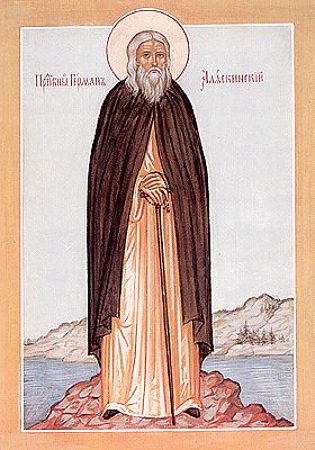
Herman of Alaska was a Russian Orthodox monk and missionary to Alaska, which was then part of Russian America. His gentle approach and ascetic life earned him the love and respect of both the native Alaskans and the Russian colonists. He is considered by many Orthodox Christians to be the patron saint of North America.

The Carthusians, also known as the Order of Carthusians, are a Latin enclosed religious order of the Catholic Church. The order was founded by Bruno of Cologne in 1084 and includes both monks and nuns. The order has its own rule, called the Statutes, and their life combines both eremitical and cenobitic monasticism. The motto of the Carthusians is Stat crux dum volvitur orbis, Latin for "The Cross is steady while the world turns". The Carthusians retain a unique form of liturgy known as the Carthusian Rite.

Anthony of Padua, OFM or Anthony of Lisbon was a Portuguese Catholic priest and friar of the Franciscan Order.
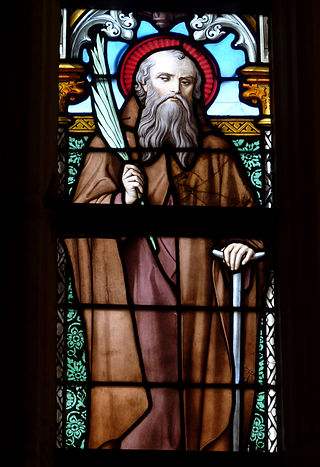
Helier was a 6th-century ascetic hermit. He is the patron saint of Jersey in the Channel Islands, and in particular of the town and parish of Saint Helier, the island's capital. He is also invoked as a healing saint for diseases of the skin and eyes.

Charbel Makhlouf, O.L.M., born Youssef Antoun Makhlouf and venerated as Saint Charbel, was a Maronite monk and priest from Lebanon. During his life, he obtained a wide reputation for holiness, and for his ability to unite Christians and Muslims and Druze.
Saint Herbert of Derwentwater was an Anglo-Saxon priest and hermit who lived on the small St Herbert's Island in Derwentwater, Cumbria, England. His friendship with St Cuthbert is explored in a poem by William Wordsworth.
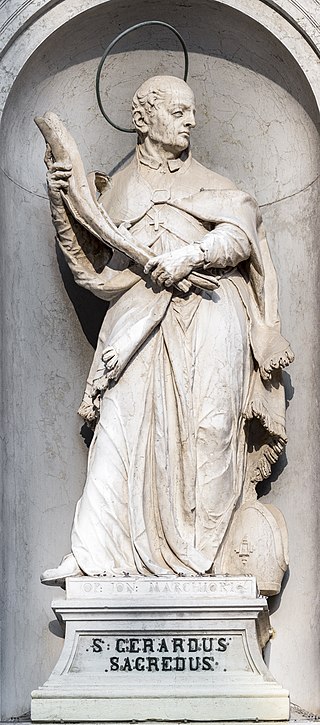
Gerard or Gerard Sagredo was the first bishop of Csanád in the Kingdom of Hungary from around 1030 to his death. Most information about his life was preserved in his legends which contain most conventional elements of medieval biographies of saints. He was born in a Venetian noble family, associated with the Sagredos or Morosinis in sources written centuries later. After a serious illness, he was sent to the Benedictine San Giorgio Monastery at the age of five. He received excellent monastic education and also learnt grammar, music, philosophy and law.

Saint Colman mac Duagh was born at Corker, Kiltartan, County Galway, Ireland, the son of the Irish chieftain Duac. He initially lived as a recluse, living in prayer and prolonged fastings, first on Inismore, then in a cave at the Burren in County Clare. With his relative, King Guaire Aidne mac Colmáin of Connacht he founded the monastery of Kilmacduagh,, and governed it as abbot-bishop.

Saint Wendelin of Trier was a hermit and abbot. Although not listed in the Roman Martyrology, his cultus is wide-spread in German-speaking areas. He is a patron of country folk and herdsmen. He is honored on October 22.
Meinrad, OSB was a German Benedictine hermit and is revered as a Catholic and Orthodox saint. He is known as the "Martyr of Hospitality". His feast day is 21 January.

The Roman Catholic hermitage of Our Lady of the Enclosed Garden is situated in the former Reformed church of Warfhuizen, a village in the extreme north of the Netherlands. It is the only Dutch hermitage currently inhabited by a hermit. The name draws upon the traditional epithet for the Virgin Mary of hortus conclusus or enclosed garden, a reference to the Song of Songs that indicates the Virgin's "perpetual virginity and at the same time her fruitful maternity".

Amator(in French)Amadour or Amatre was bishop of Auxerre from 388 until his death on 1 May 418 and venerated as a saint in the Catholic Church. Amator's feast day is celebrated on 1 May.

Monsanto is a village in the civil parish of Monsanto e Idanha-a-Velha, in the municipality of Idanha-a-Nova, District of Castelo Branco, Portugal. In 2011, it covered an area of 131.76 km² and had 828 inhabitants. Monsanto would become popularly known as "the most Portuguese village of Portugal" due to a government-sponsored competition that awarded twelve historic villages the distinction of Most Portuguese Village of their own province in 1938.
Saint John of Egypt,, also known as John the Hermit, John the Anchorite, or John of Lycopolis, was one of the hermits and grazers of the Nitrian Desert. He began as a carpenter but at the age of twenty-five began to live a life of solitude.

A hermitage most authentically refers to a place where a hermit lives in seclusion from the world, or a building or settlement where a person or a group of people lived religiously, in seclusion. Particularly as a name or part of the name of properties its meaning is often imprecise, harking to a distant period of local history, components of the building material, or recalling any former sanctuary or holy place. Secondary churches or establishments run from a monastery were often called "hermitages".

Saint Romanus of Rouen was a scribe, clerical sage, and bishop of Rouen. He would have lived under Dagobert I (629–39), though his date of birth is unknown. His life is known in legend and tradition and is shown in the stained glass windows and south gate of Rouen Cathedral and the stained glass windows of the église Saint-Godard (1555). The Catholic Encyclopedia claims that his legend has little historical value with little authentic information. He was both Lord Chancellor of France and Référendaire of France..
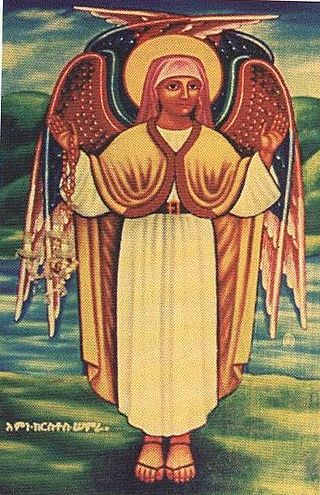
Kristos Samra was an Ethiopian female saint who founded an eponym monastery in Lake Tana.
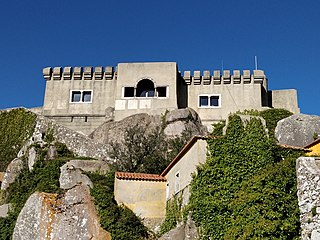
The Sanctuary of Peninha is situated in the Sintra Mountains in the Sintra-Cascais Natural Park, in the Lisbon District of Portugal. It stands at an altitude of 448 metres on top of a rocky outcrop, which provides views over the coastline and inland areas. In addition to a baroque chapel, completed in 1710, the location contains the Palace of Peninha, which dates from 1918, as well as remains of a hermitage. The interiors of neither the chapel nor the palace can presently be visited.

Serenidus of Saulges was a 7th-century Italian Benedictine monk. His feast day is celebrated on May 7, with his brother Serenicus, or locally on August 16.
Abba Pitirim of Porphyry or Pitirim of Egypt was an Egyptian Christian monastic and saint of the fourth century, and a disciple of Anthony the Great. His feast day is November 29 in the Orthodox Church.
References
- 1 2 "St. Amator - Saints & Angels".
- 1 2 "Saint Amador - Nominis".
- ↑ Jorge Cardoso: Agiológio lusitano dos sanctos varoems illustres em virtude do reino de Portugal e suas conquistas. Lisboa: Officina Craesbeekiana, 1652, vol. 2, pp. 320–321 (online version)